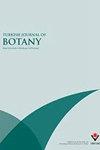Pollen morphology of some Tanacetum L. (Asteraceae) taxa and its systematic value
IF 1.5
4区 生物学
Q3 PLANT SCIENCES
引用次数: 0
Abstract
Pollen grains of 24 Tanacetum taxa from Türkiye were examined by light (LM) and scanning electron microscopy (SEM). Detailed pollen morphological characteristics are provided for these taxa. According to the 24 analyzed taxa, T. parthenifolium has the smallest pollen grains, and T. aurem var. aurem possesses the largest ones. The basic shape of the pollen grains in most taxa is oblatespheroidal. However, suboblate pollen grains are recorded for T. balsamitoides, T. aurem var. aurem, and T. tomentellum. The polar axis ranges from 16.56 to 26.14 µm, and the equatorial diameter ranges from 17.64 to 30.12 µm in this study. The grains are trizonocolporate, and exine sculpturing is echinate in all taxa. The ornamentations between spines are reticulate, microreticulate, perforate, microperforate, perforate-granulate, microperforate-granulate, rugulate-granulate, and rugulate-perforate. Pollen morphological characteristics of the taxa studied are compared and discussed on the basis of taxonomical concepts. The unweighted pair group approach with arithmetic mean was also employed to assess the morphological differentiation of the pollen, and four types were identified in the dendrogram created from the studied data using this method. In addition, principal component analysis confirms the dendrogram results. In some cases, the pollen characters are useful in distinguishing the taxa.一些菊科柽柳属植物的花粉形态及其系统价值
采用光镜(LM)和扫描电镜(SEM)对 rkiye Tanacetum 24个分类群的花粉粒进行了研究。这些分类群具有详细的花粉形态特征。在分析的24个分类群中,parthenifolium的花粉粒最小,而T. aurem var. aurem的花粉粒最大。大多数分类群花粉粒的基本形状为扁球形。然而,balsamitoides、T. aurem var. aurem和T. tomentellum的花粉粒均为半球形。极轴范围为16.56 ~ 26.14µm,赤道直径范围为17.64 ~ 30.12µm。在所有的分类群中,颗粒是三合一的,外壁雕刻是棘刺的。刺之间的纹饰为网状、微网状、穿孔、微穿孔、穿孔-颗粒、微穿孔-颗粒、规则-颗粒和规则-穿孔。在分类概念的基础上,对所研究分类群的花粉形态特征进行了比较和讨论。采用带算术平均值的非加权对群法对花粉的形态分化进行了评价,并在该方法生成的树状图中鉴定出了4种类型。此外,主成分分析证实了树状图的结果。在某些情况下,花粉特征对区分分类群是有用的。
本文章由计算机程序翻译,如有差异,请以英文原文为准。
求助全文
约1分钟内获得全文
求助全文
来源期刊

Turkish Journal of Botany
PLANT SCIENCES-
CiteScore
2.90
自引率
5.60%
发文量
31
审稿时长
6-12 weeks
期刊介绍:
The Turkish Journal of Botany is published electronically 6 times a year by the Scientific and Technological Research Council of Turkey (TÜBİTAK) and accepts manuscripts (in English) covering all areas of plant biology (including genetics, evolution, systematics, structure, function, development, diversity, conservation biology, biogeography, paleobotany, ontogeny, functional morphology, ecology, reproductive biology, and pollination biology), all levels of organisation (molecular to ecosystem), and all plant groups and allied organisms (algae, fungi, and lichens). Authors are required to frame their research questions and discuss their results in terms of major questions in plant biology. In general, papers that are too narrowly focused, purely descriptive, or broad surveys, or that contain only preliminary data or natural history, will not be considered (*).
The following types of article will be considered:
1. Research articles: Original research in various fields of botany will be evaluated as research articles.
2. Research notes: These include articles such as preliminary notes on a study or manuscripts on the morphological, anatomical, cytological, physiological, biochemical, and other properties of plant, algae, lichen and fungi species.
3. Reviews: Reviews of recent developments, improvements, discoveries, and ideas in various fields of botany.
4. Letters to the editor: These include opinions, comments relating to the publishing policy of the Turkish Journal of Botany, news, and suggestions. Letters should not exceed one journal page.
(*) 1. Raw floristic lists (of algae, lichens, fungi, or plants), species descriptions, chorological studies, and plant sociology studies without any additional independent approaches.
2. Comparative morphology and anatomy studies (that do not cover a family, tribe, subtribe, genus, subgenus, section, subsection, or species complexes with taxonomical problems) without one or more independent additional approaches such as phylogenetical, micromorphological, chromosomal and anatomical analyses.
3. Revisions of family, tribe, genus, subgenus, section, subsection, or species complexes without any original outputs such as taxonomical status changes, IUCN categories, and phenological and ecological analyses.
4. New taxa of all plants without any additional independent approaches such as phylogenetical, ecological, chromosomal, chorological and correlational analyses in addition to a detailed macro- and micro-morphological descriptions with quality field and microscopic illustrations of taxonomically important structures and identification key in the taxonomic group.
New records of all plants without any additional independent approaches such as phylogenetical, ecological, chromosomal, chorological and correlational analyses in addition to a detailed macro- and micro-morphological descriptions with quality field and microscopic illustrations of taxonomically important structures and identification key in the taxonomic group may be accepted for peer review if they contain 3 or more new records or taxonomical status update, such as lectotypification, new combinations, transfers, revivals and synonyms.
5. New taxa of algae, lichens, and fungi without any additional independent approaches such as phylogenetical, ecological, chromosomal, chorological and correlational analyses in addition to a detailed macro- and micro-morphological descriptions with quality field and microscopic illustrations of taxonomically important structures and identification key in the taxonomic group.
New records of algae, lichens, and fungi without any additional independent approaches such as phylogenetical, ecological, chromosomal, chorological and correlational analyses in addition to a detailed macro- and micro-morphological descriptions with quality field and microscopic illustrations of taxonomically important structures and identification key in the taxonomic group may be accepted for peer review if they contain 5 or more new records or taxonomical status update, such as lectotypification, new combinations, transfers, revivals and synonyms.
 求助内容:
求助内容: 应助结果提醒方式:
应助结果提醒方式:


